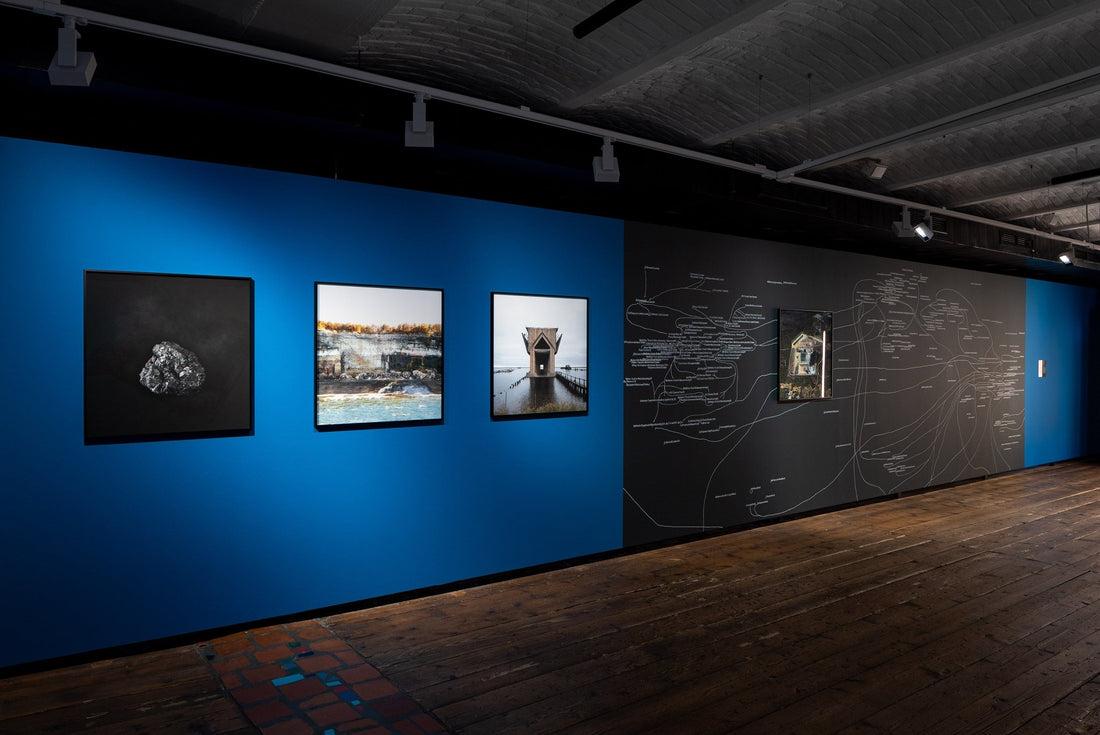
"Cobalt" photographs
Share
Artist Mary Mattingly builds a portrait of her camera through the minerals and metals that make it. Here she focuses on Cobalt.
Cobalt is considered a “strategic metal” by the United States government. Strategic metals are defined as commodities integral to the national defense, aerospace, and energy industries, but threatened by supply disruptions due to limited domestic production. Worldwide, fifty percent of cobalt is used in the chemical industry to make pigments for glass, cloth, and porcelain as well as binders, drying agents, nuclear energy, and fertilizer. Superalloys from cobalt comprise 20% of the global market and include hard metals, permanent magnets, carbides, and rechargeable batteries. The U.S. military consumes 62% of the world’s supply of cobalt.




In an era nationally defined by industrial labor’s exportation, Michigan’s Protect and Grow, part of the Michigan Defense Center’s “Arsenal of Innovation” is touted as one answer to a challenging consumer-industrial sector in the USA. With Protect and Grow, parts of Michigan’s auto industry are transformed to produce military-grade weapons and vehicles. The University of Michigan’s Automotive Research Center and other institutions are also in transformation, with programs like the United States Army Tank Automotive Research, Development, and Engineering Center. In late 2014, Michigan became one of three states producing cobalt, from a nickel mine north of Marquette called Eagle Mine. Currently, anywhere from 50-70% of cobalt extraction happens in the Democratic Republic of Congo. After being mined, it’s purchased by companies such as Huayou Cobalt (registered in China). Huayou Cobalt acquired one of the largest cobalt mining permits in the Democratic Republic of Congo. It sells refined cobalt to consumer market clients including Apple (registered USA), LG Chem (registered Korea), Sony (registered USA), and Volkswagen (registered Germany). Studying the production, distribution, and use of Cobalt was the starting point for this exhibition. From craft objects to Impressionist painting and the contemporary Alev Ebüzziya Siesbye, Cobalt Blue has a significant art history. What does it mean though, to work with materials that are both seductive and linked to contemporary forms of violence? If the exhibition is a form of storytelling—what do these objects say? Because of their ubiquity, the objects in the exhibition may veil their colonial histories, but in their modern replications, they implicate users in a massive extraction-based neocolonialism that can be deadly to the humans working in and living near mines. This is an extraction that also sacrifices land, water, air, and animal life for economic gain. The exhibition includes photographs and objects, many transformed through boxing, bundling, rolling, cutting, stretching, and crushing; all techniques used to alter Cobalt.


The work of Mary Mattingly suggests an undeniable suspension of disbelief, a leap of some brand of faith, but with eyes open. Her work and ideas are striking, and precipitate a change in consciousness… to foresee a place that doesn’t pretend to be utopia, but instead offers an alternative way of being, of thinking that is dependent on the stark reality of our choices made or unmade, unadorned. What are we willing to sacrifice in the process to ultimately secure a sustainable way of life and respectful co-existence?
During her fellowship at the University of Michigan, Mattingly traveled to the Upper Peninsula, exploring its terrain and cobalt mines. She thrifted for glassware and other goods, visited trash sites, met with metal workers, and airplane mechanics. She engaged with students at U-M from diverse departments collecting personal objects for a sacred burial on the Diag, a related project to her installation in the gallery. Each workshop included the ritual of tea, storytelling, drawing, but also 3D imaging which became part of her digital archives. There was never any sense that she placed more value on one object or another, or one ritual, but rather, and all became part of a bundle.
In preparation for her exhibition, the cumulative cobalt hue of her studio at U-M Stamps School which was comprised of her forgings…blue glass, blue powder, blue fabrics, blue pipes, was both infatuating and intoxicating. Scales and diagrams, photographs taken on location, and a series of carefully orchestrated suspensions and pulleys all seemed to potentially lead us to some peculiar and certain destination, a Eureka moment of an exalted explorer, a promise. Perhaps the true brilliance was the way everything seemingly converged, only to reveal loose ends, connections and disconnections, a network of tangents, a mesh of turns, the various routes of mazes. The work Mary Mattingly creates can only exist because, although she fully recognizes the impossibility of things, she insists on residing in the realm of the possible.
—Amanda Krugliac, Curator at U-M Institute for the Humanities
